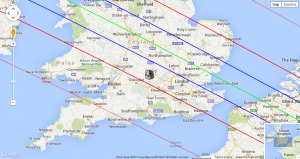This was my fifth positive asteroid occultation and my second of 2014. It featured a faint star (mag. 10.6) in Leo with a gibbous Moon 42º distant but only at an altitude of 6º.
- Predicted event time was 02:02:29 UTC for my observing position.
- Predicted maximum duration was 7.8 seconds with a 3.9 magnitude drop.
- Position was 83 km southwest from the predicted central line in the 1-sigma zone, 43km outside the shadow path.
- Calculated probability of seeing the occultation was 20.4%.

In the map above the predicted shadow zone is between the blue lines, the predicted centre of the occultation is the green line. The red lines indicate the 1-sigma zone. The location of my station is shown by the observatory icon.
I recorded 160ms integrations using a Watec 120N video camera on a 300mm F/4 Newtonian telescope. Video was captured via a USB2 capture device on a laptop with VirtualDub software. I used a timestamp from a Blackbox GPS video time inserter.
The occultation occurred almost exactly at the predicted time. Here is a short clip of the recorded video showing the occultation. The occulted star is right of centre, a comparison star can be seen left of centre.
This is the light curve for the event from video analysis in AOTA (Asteroidal Occultation Time Analyser).

Nb. the timings below are corrected for internal delays in the camera and for the integration period in accordance with G. Dangl.
| Start | 02:02:24.79 | ±0.08s |
| End | 02:02:32.23 | ±0.08s |
| Duration | 7.44s | ±0.16s |
There were no other successful observations of this occultation. My chord gives a minimum diameter of the asteroid of 62km.